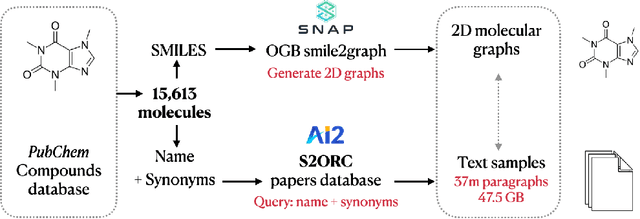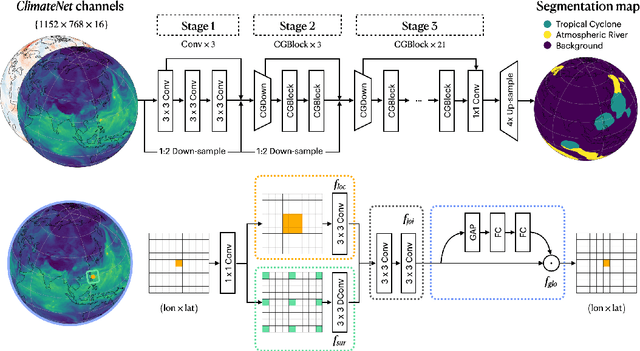Romain Lacombe
Stanford University, Plume Labs
Accelerating the Generation of Molecular Conformations with Progressive Distillation of Equivariant Latent Diffusion Models
Apr 21, 2024Abstract:Recent advances in fast sampling methods for diffusion models have demonstrated significant potential to accelerate generation on image modalities. We apply these methods to 3-dimensional molecular conformations by building on the recently introduced GeoLDM equivariant latent diffusion model (Xu et al., 2023). We evaluate trade-offs between speed gains and quality loss, as measured by molecular conformation structural stability. We introduce Equivariant Latent Progressive Distillation, a fast sampling algorithm that preserves geometric equivariance and accelerates generation from latent diffusion models. Our experiments demonstrate up to 7.5x gains in sampling speed with limited degradation in molecular stability. These results suggest this accelerated sampling method has strong potential for high-throughput in silico molecular conformations screening in computational biochemistry, drug discovery, and life sciences applications.
AdsorbRL: Deep Multi-Objective Reinforcement Learning for Inverse Catalysts Design
Dec 04, 2023Abstract:A central challenge of the clean energy transition is the development of catalysts for low-emissions technologies. Recent advances in Machine Learning for quantum chemistry drastically accelerate the computation of catalytic activity descriptors such as adsorption energies. Here we introduce AdsorbRL, a Deep Reinforcement Learning agent aiming to identify potential catalysts given a multi-objective binding energy target, trained using offline learning on the Open Catalyst 2020 and Materials Project data sets. We experiment with Deep Q-Network agents to traverse the space of all ~160,000 possible unary, binary and ternary compounds of 55 chemical elements, with very sparse rewards based on adsorption energy known for only between 2,000 and 3,000 catalysts per adsorbate. To constrain the actions space, we introduce Random Edge Traversal and train a single-objective DQN agent on the known states subgraph, which we find strengthens target binding energy by an average of 4.1 eV. We extend this approach to multi-objective, goal-conditioned learning, and train a DQN agent to identify materials with the highest (respectively lowest) adsorption energies for multiple simultaneous target adsorbates. We experiment with Objective Sub-Sampling, a novel training scheme aimed at encouraging exploration in the multi-objective setup, and demonstrate simultaneous adsorption energy improvement across all target adsorbates, by an average of 0.8 eV. Overall, our results suggest strong potential for Deep Reinforcement Learning applied to the inverse catalysts design problem.
ClimateX: Do LLMs Accurately Assess Human Expert Confidence in Climate Statements?
Nov 28, 2023Abstract:Evaluating the accuracy of outputs generated by Large Language Models (LLMs) is especially important in the climate science and policy domain. We introduce the Expert Confidence in Climate Statements (ClimateX) dataset, a novel, curated, expert-labeled dataset consisting of 8094 climate statements collected from the latest Intergovernmental Panel on Climate Change (IPCC) reports, labeled with their associated confidence levels. Using this dataset, we show that recent LLMs can classify human expert confidence in climate-related statements, especially in a few-shot learning setting, but with limited (up to 47%) accuracy. Overall, models exhibit consistent and significant over-confidence on low and medium confidence statements. We highlight implications of our results for climate communication, LLMs evaluation strategies, and the use of LLMs in information retrieval systems.
Extracting Molecular Properties from Natural Language with Multimodal Contrastive Learning
Jul 22, 2023



Abstract:Deep learning in computational biochemistry has traditionally focused on molecular graphs neural representations; however, recent advances in language models highlight how much scientific knowledge is encoded in text. To bridge these two modalities, we investigate how molecular property information can be transferred from natural language to graph representations. We study property prediction performance gains after using contrastive learning to align neural graph representations with representations of textual descriptions of their characteristics. We implement neural relevance scoring strategies to improve text retrieval, introduce a novel chemically-valid molecular graph augmentation strategy inspired by organic reactions, and demonstrate improved performance on downstream MoleculeNet property classification tasks. We achieve a +4.26% AUROC gain versus models pre-trained on the graph modality alone, and a +1.54% gain compared to recently proposed molecular graph/text contrastively trained MoMu model (Su et al. 2022).
Improving extreme weather events detection with light-weight neural networks
Mar 31, 2023



Abstract:To advance automated detection of extreme weather events, which are increasing in frequency and intensity with climate change, we explore modifications to a novel light-weight Context Guided convolutional neural network architecture trained for semantic segmentation of tropical cyclones and atmospheric rivers in climate data. Our primary focus is on tropical cyclones, the most destructive weather events, for which current models show limited performance. We investigate feature engineering, data augmentation, learning rate modifications, alternative loss functions, and architectural changes. In contrast to previous approaches optimizing for intersection over union, we specifically seek to improve recall to penalize under-counting and prioritize identification of tropical cyclones. We report success through the use of weighted loss functions to counter class imbalance for these rare events. We conclude with directions for future research on extreme weather events detection, a crucial task for prediction, mitigation, and equitable adaptation to the impacts of climate change.
 Add to Chrome
Add to Chrome Add to Firefox
Add to Firefox Add to Edge
Add to Edge